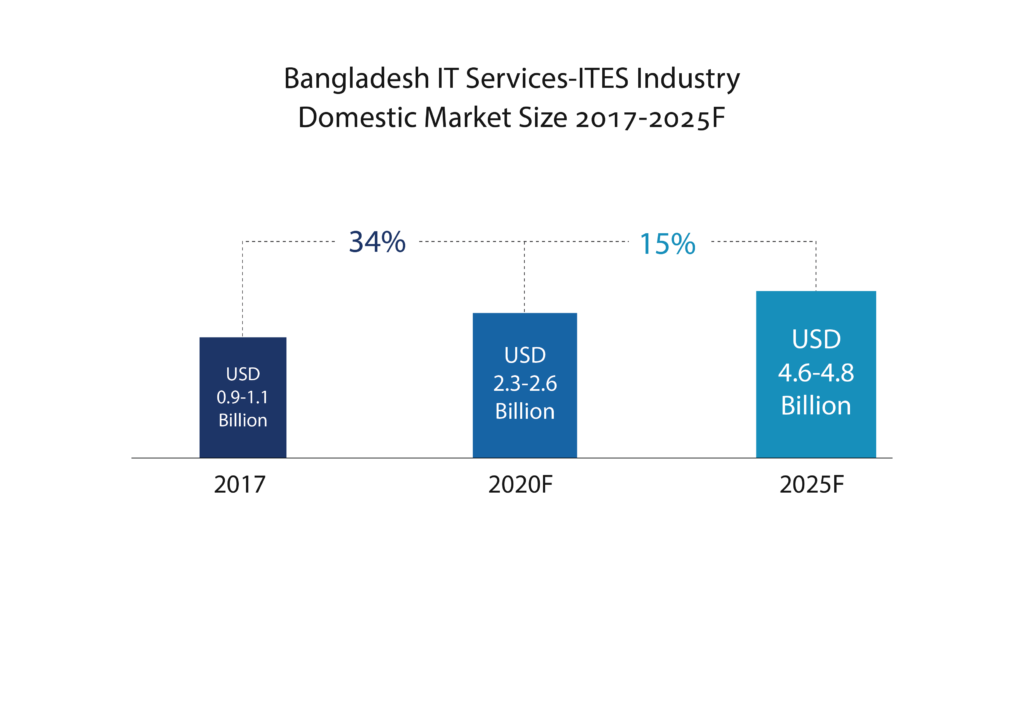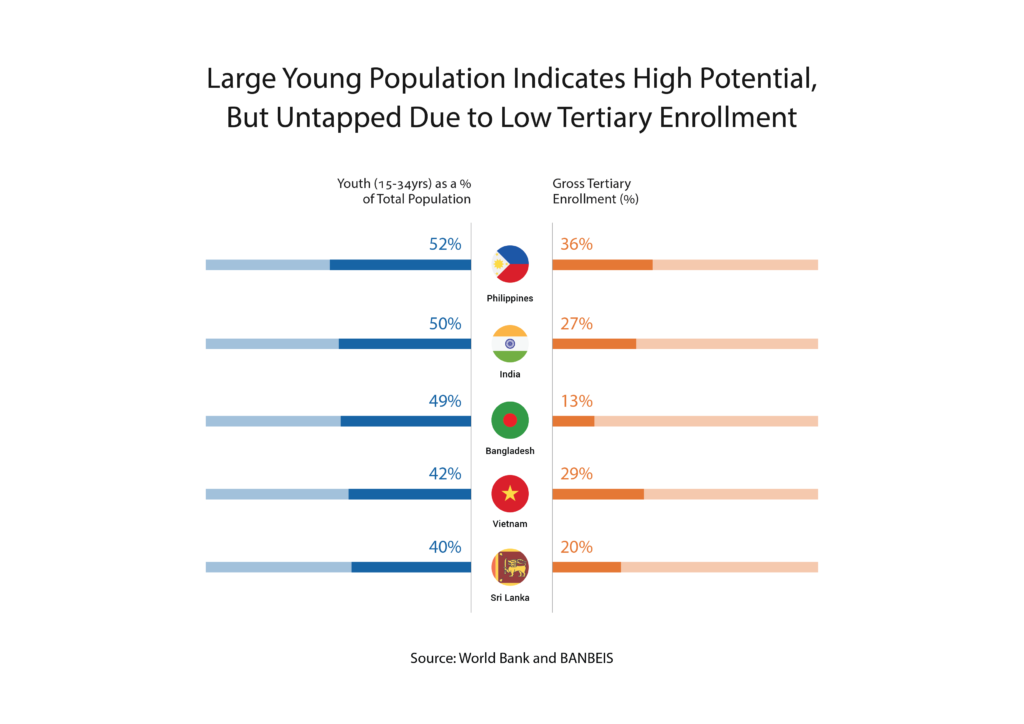GET IN TOUCH
- Please wait...

Economic growth is transforming Bangladesh, building its pathway to becoming a middle-income economy. Bangladesh is a fast growing economy, with a GDP growth of over 7 percent in fiscal year 2018 keeping up an impressive annual average growth rate of more than 6 percent over the last ten years. Bangladesh has multiple factors that favor continued strong economic growth – a steady inflation rate of 5 to 6 percent in the last five years and a record high forex reserve of USD 33.5 billion as of 2017. [1] Skills Gap in the IT Sector creates opportunities for undertaking initiatives and programs to utilize our youth.
The Government of Bangladesh is aggressively pursuing a digital agenda to enhance the local information communication technology ecosystem by channeling large investments into the sector and undertaking large infrastructure projects. The Government’s Vision 2021 and the Seventh Five-Year Plan (2016–2021) called for a shift to a new development paradigm. As part of the vision of “Digital Bangladesh,” the government promotes information technology (IT)/IT enabled service (ITES) industry (IT industry in short) is the next growth engine, after the garment industry, as well as the means for providing better public services. [2]
The Bangladesh IT market is currently valued at USD 1 billion with an exponential growth forecast of becoming 5 times its size and reaching USD 4.8 billion by 2025. The IT industry in Bangladesh, though significantly smaller than offshoring giants such as India and the Philippines, has demonstrated one of the highest growth rates globally, indicating a huge untapped potential and has increased the interest of investors. The domestic industry is expected to generate revenues of USD 0.9 to 1.1 billion in 2017 and grow nearly fivefold to reach USD 4.6 to 4.8 billion by 2025. This is remarkably higher than the overall growth forecast for either an established peer location such as India (10 to 13 percent CAGR for 2017-2020) or an emerging peer location such as Vietnam (12 to 15 percent CAGR for 2017-2020). [3]

The IT services industry within Bangladesh has been growing, serving international and domestic clients in the banking and telecom sectors. Bangladesh’s emerging IT outsourcing players already have strong credentials, and the Bangladeshi freelancer community has supplemented IT exports. Bangladesh is consistently ranked among the top freelance work locations on employment websites like oDesk, eLance and the likes. [4] There are over 1,500 registered software and IT-enabled services (ITES) companies in Bangladesh. Among these, over 1,100 companies are members of the Bangladesh Association of Software and Information Services (BASIS). Bangladesh export software and ITES to more than 60 countries around the world and the number of exporting companies – excluding freelancers – are about 400. [5]
Telecom, banking and manufacturing industries are driving the demand for digital services in Bangladesh. With companies growing at scale and rapid technology adoption among the population, digital solutions such as ERP systems, payment systems, big data analytics have become indispensable to keep up with the evolving industry dynamics and not become redundant. Certain local players have begun serving other nations in the South Asian region such as Nepal, Bhutan and Myanmar that have embarked on a similar journey towards digitization as Bangladesh. Services availed by these economies are traditional ERP, microfinance, Islamic banking for the finance and insurance industries.[6]
With more than half the population below the age of 25 years, one of the youngest Bangladesh has a high number of students graduating from its universities every year. In 2017 alone, 3.2 million students were enrolled in tertiary level education compared to 1.6 million in 2015. The total tertiary enrollment over the next decade (2016-2026) may reach 4.6 million according to an estimate made by the University Grants Commission (UGC) of Bangladesh.[7] With 38 public and 92 private universities, Bangladesh churned out 543,000 tertiary graduates in 2016-17. Of the total pool, nearly 16,000 have IT-related degrees, and 126,000 have business-related degrees. At a city-level, Dhaka has the highest concentration of talent with 63,000-67,000 tertiary graduates annually, which is higher than several competing global services destinations. Dhaka’s local talent pool is further amplified with the migration of talent from other parts of the country. Bangladesh have about 90 private universities, half of which have ICT faculties, and 70 public universities, some of which also provide ICT courses.[8]
However, lack of good talent and weak infrastructure hinder the growth of IT firms in Bangladesh. Most of the IT firms in Bangladesh are relatively new and small-sized and a small number of international IT firms operate on a limited scale. While weak IT infrastructure and branding are issues, Bangladesh lack skilled workers at different levels in quality and quantity. As the IT sector in Bangladesh is growing rapidly, there is a shortage of ready-trained talent. Most companies plateau around 300-400 full-time equivalent scale, with around 100 employees having technical knowledge and capabilities, and leverage the freelancer pool to handle overflow volumes.[9]

Only 0.3 percent of Bangladesh’s labor force are employed in the Information and Communication industry. Bangladesh’s labor force participation rate (the proportion of population aged 15 or older who were currently economically active) in 2015-16 was estimated at 58.5 percent. Of those employed, just 5.3 percent have attained tertiary level of education.[11]
Skills development, or lack thereof, therefore, turns out to be a colossal problem. One salient reason for that is the unavailability of good, quality training institutions. Many of them are currently unable to respond to the market needs. Nascent market conditions are likely to be challenging with respect to prevalence of middle-level management, experienced resources, and presence of ancillary services (e.g., recruiters and training providers). In fact, the recent Bangladesh Institute of Development Studies (BIDS) report clarified that IT sector require university graduates, and there is a huge demand for programmers, system analyst, software engineers and quality assurance specialists. Similarly, existing supply of project and product managers (mid-level professionals) and graphic designers is in shortage. IT companies also require work in collaboration. While people can make breakthroughs with Computer Science theory, application requires a team—a critical mass.
The quality of education has direct implications to employability of university graduates, as factors beyond subject knowledge such as soft skills, on-the-job training (OJT) or career guidance can determine whether a student will attain a job after graduation. 74 percent of start-up founders agree that universities are failing to provide a high-quality IT education. Many contend that university courses are based on outdated curriculums and technologies, and suffer from a dearth of qualified professors and teachers. Moreover, employers have mentioned two types of skills shortages:
(a) not enough graduates in specialized skills needed within high growth sectors, and
(b) where graduates have these skills, they are still not employable because skills in English language, computer, communication and problem-solving abilities are absent.
Furthermore, absence of quality assurance mechanism is a critical issue in Bangladesh.
Each public and private university relies on its own mechanism to ensure quality. For public universities, the mechanism includes curriculum reviews by the curriculum committee, assessment of achievement and designing future action plans by the Academic Council. There is no provision for external review of quality for the universities. The UGC carries out monitoring of private universities to a limited degree. The private universities need UGC’s permission to open and operate departments. However, many of the private universities have failed to meet the minimum requirements of physical infrastructures, fulltime qualified faculty, libraries, teaching aids and other facilities to provide proper education.[12]
To tackle the issue of skill gap in the IT sector, coordinated efforts are required from the academia, the industry and the Government. There needs to be a match between industry expectations and expectations of job seekers in the IT sector. To begin with, the industry can set standards by developing a qualifications grid, a salary range, and detailed skill requirement for positions in IT companies as they reach out to universities for recruitment, or when they advertise their posts. The required skill sets and qualifications grid would enable students and graduates to better manage expectations, while providing academia with an up-to-date list of required skill sets with which to adjust its curriculum.[13]
In this way the industry can benefit in tailoring the talent pool to suit specific needs and acquiring adequately skilled graduates as employees. Ideally, this could lead to more standardized curricula across all institutions and foster deeper collaboration between them. There should be a centralized and coordinated process to test/assess the skills set of a fresh graduate. Post graduation, candidates must have a chance to further enhance their skills, and this can only be made possible if organizations come forward and invest in their development.
Our experts can help you solve your unique challenges
Stay up-to-date with our Thought Leadership and Insights